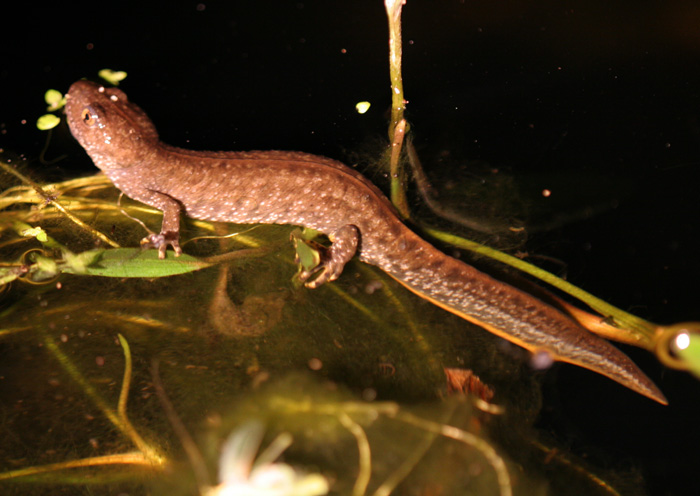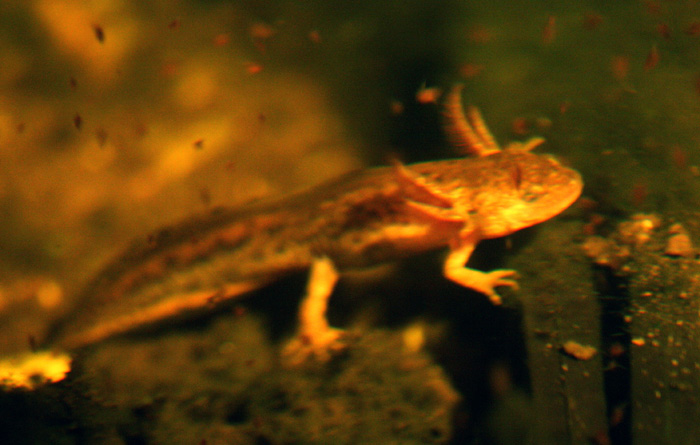 |
 |
Photographing animals in ponds at night: |
| Author | Message |
|
Vicar Senior Member Joined: 02 Sep 2004 No. of posts: 1181 View other posts by Vicar |
Posted: 14 Aug 2008 Hrm... Just started trying this, not as easy as it seems. Ideally I want to get some in situ shots of the newts in the pond, and am making some fiendish devices  . Any tips ? . Any tips ?First (and only in-focus - sort of) attempt.  Steve Langham - Chairman 
Surrey Amphibian & Reptile Group (SARG). |
|
Caleb Forum Coordinator Joined: 17 Feb 2003 No. of posts: 448 View other posts by Caleb |
Posted: 15 Aug 2008 I've never had much luck with this, I'd be interested to know how you get on. Presumably you're using a polarising filter- do you have a ringflash? I've not been able to justify the expense for one as yet... I've heard of people using glass/perspex boxes pushed partway under the water to take underwater photos- it doesn't seem very portable, though. |
|
will Senior Member Joined: 27 Feb 2007 No. of posts: 330 View other posts by will |
Posted: 15 Aug 2008 I guess some spoilsport should add that GCN photography even in situ using a flash would require a licence.. |
|
Vicar Senior Member Joined: 02 Sep 2004 No. of posts: 1181 View other posts by Vicar |
Posted: 15 Aug 2008 OK Some progress...but a still a long way to go. Currently using an old plastic waste paper bin with a hole cut into the bottom and an acetate sheet over the end. Not using flash, but a low power torch and winding the ISO up to 1600 (hence the grains). Sharp focus is proving difficult, despite a crystal clear view through the viewfinder. But....this is an image from the bottom of my pond! Totally fascinating watching him gobble up daphnia...and at quite a rate...he's striking every5 seconds or so. Shutter speed so way too slow to capture feeding action.  PS, I am licensed...and may try a couple of flash photos to see if it helps, but I think I've got to crack the focus issue first. Steve Langham - Chairman 
Surrey Amphibian & Reptile Group (SARG). |
|
Peter Senior Member Joined: 17 Jan 2008 No. of posts: 260 View other posts by Peter |
Posted: 15 Aug 2008 Interesting pics and very interesting challenge Steve. I look forwwrd to seeing more updates.  
|
|
tim-f Senior Member Joined: 13 Apr 2008 No. of posts: 60  View other posts by tim-f |
Posted: 12 Sep 2008 Hey Vicar. Bear in mind, I'm no expert! I don't know what kit you're using, but suspect a digital compact. Things counting against you:
I suggest:
Hope these ramblings help. If you want any more info, drop me a PM, as I don't check this site very often. Good luck, Tim.
|
|
Vicar Senior Member Joined: 02 Sep 2004 No. of posts: 1181 View other posts by Vicar |
Posted: 12 Sep 2008 Hi Tim, Thanks for the comments. I'm using a Canon D20 DSLR with ISO wound up to 1600 (although slightly better results at 800) with Tamron 180mm prime macro lens, set up on an Ecorest tripod with Manfrotto head. Using an off-camera IR-triggered speedlight flash at an oblique angle. Results so far through new acetate appears to be a better compromise than the slightly odd proportions given by refraction through the water surface (off course this isn't a problem if shooting at 90? to the surface, but composition ends up rather 'flat'). I've got no problems with results in a tank set up, its trying this in-situ that seems to present an extra layer of difficulty (not least..stalking the animals). The goal I would like to get to is to produce reasonable images of submerged aquatic amphibians behaving naturally in their wild environment using portable equipment. I think its going to be a question of trial and error. I have a fair grasp of photographic 'basics', and I totally agree that lighting is one of the key challenges. My understanding was that acetate was better optically matched against water than glass? (and is easier to work and lighter...might be useful in a portable design.) I've not had much of a chance to experiment since the last post, but have an idea of using a kind of extended lens hood which would penetrate the water (eliminating refraction at other than overhead angles) which would be more portable, and easier to submerge than a plastic bin weighted with concrete!! Nothing wrong with your comments...but some of the assumptions missed the mark....not that you could have known. I'll have another crack when I take some leave soon. Steve Langham - Chairman 
Surrey Amphibian & Reptile Group (SARG). |
|
tim-f Senior Member Joined: 13 Apr 2008 No. of posts: 60  View other posts by tim-f |
Posted: 19 Sep 2008 Well that's assumptions for you! I think the extended lens hood idea sounds much better. I suspect that you're shooting through the acetate at an angle - this is maybe contributing to the dodgy image quality and colour cast (chromatic aberration?)? For info, Aquapac do an underwater "housing" for SLRs for about ú80 - okay to about 5m apparently. Not sure what length of lens it will accomodate though. So why isn't the flash getting through? If it's above the surface, maybe it's tending to bounce off the surface? Could you put that in the bin and closer to the subject? Must be great fun for the neighbours watching you at work! I look forward to seeing your next attempts. Tim. |
|
Suzi Senior Member Joined: 06 Apr 2005 No. of posts: 860 View other posts by Suzi |
Posted: 19 Sep 2008 Ten years ago or more my neighbours would have seen me and my son sat out in the garden in the dark on plastic chairs gazing at a back-lit white sheet in the hope of seeing interesting moths landing. Or sat out well wrapped up in umpteen layers of clothes in many degrees of frost watching for an eclipse of the moon - again on the plastic chairs. Keeps 'em guessing! Suz |
- Photographing animals in ponds at night |